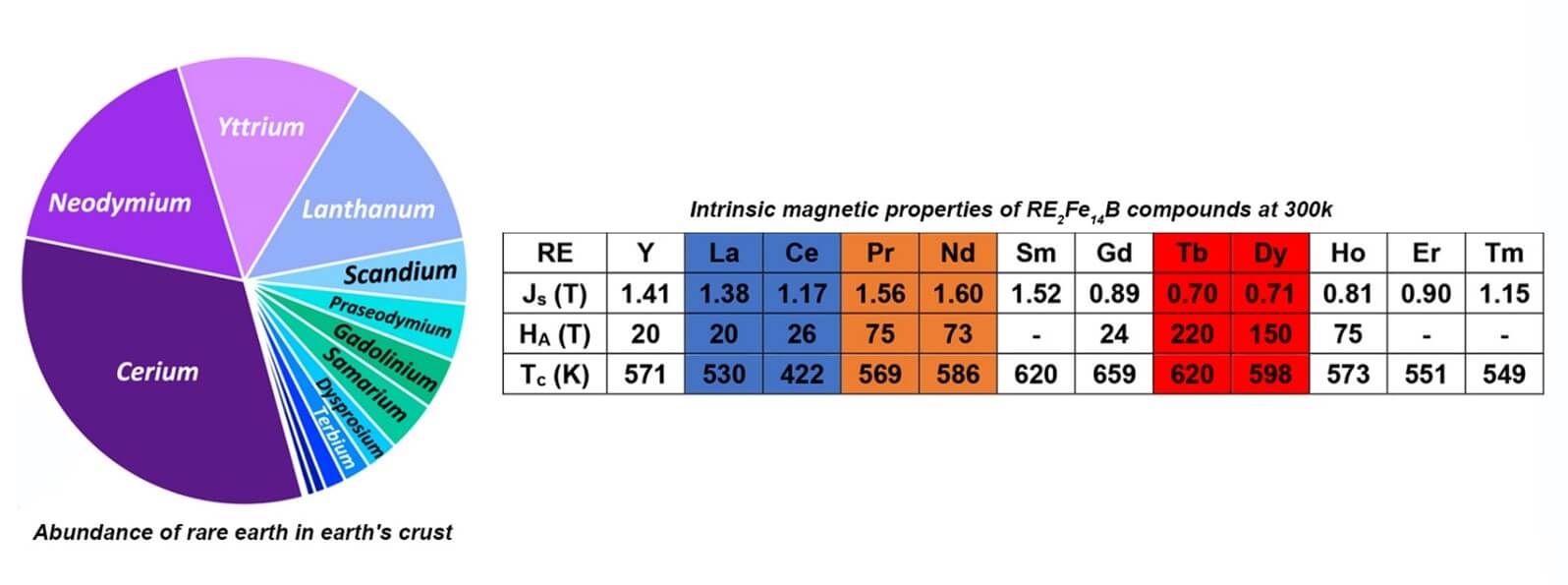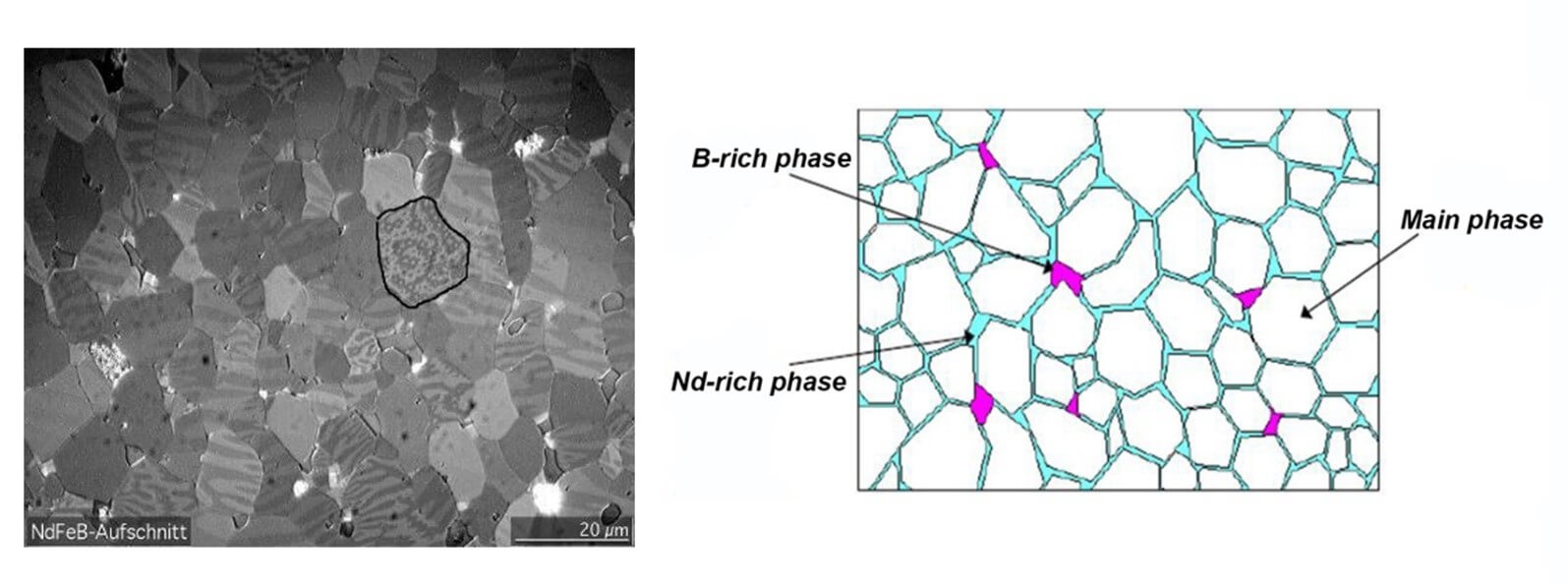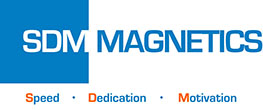Whether permanent magnet has practicability or not can be determined by its magnetic performance stability under different external conditions. Higher Br and Hcj can serve stronger magnetic field strength and much better anti-interference ability, respectively. (BH)max value represents permanent magnet’s ability to offer magnetostatic energy. Magnet with higher (BH)max can supply same magnetic field strength with less consumption, then development history of the permanent magnet is essentially progress to pursue higher magnetic performance.

Most of rare earth elements can form RE2Fe14B compound with Iron (Fe) and Boron (B), then Nd2Fe14B compound owns the highest saturation magnetization among these RE2Fe14B compounds. Nd2Fe14B compound also has functional magnetocrystalline anisotropy field. In addition, reserve volume of Neodymium in Earth’s crust is relatively abundant which can maintain supply chain stability and cost advantage.

Many microstructure observations indicate that there are six phases exist in the sintered Neodymium magnet. Nd2Fe14B main phase and Nd-rich phase are the better known due to their significant effects on the magnetic performance. Nd2Fe14B main phase is the only hard magnetic phase in the sintered Neodymium magnet and its volume fraction will determine Br and (BH)max. Nd-rich phase plays a key role in magnetic hardening of sintered Neodymium magnet. Composition, structure, distribution, and morphology of Nd-rich phase are highly sensitive to the process conditions. Nd-rich phase is preferably in the form of layered structure and continuous distributed in grain boundary areas.

Coercivity Enhancement of Sintered Neodymium Magnet
Wind power generator, new energy vehicle, energy-saving household appliances, and latest mobile intelligent terminal are all require sintered Neodymium magnet has the high (BH)max and Hcj. It always a major issue to enhance Hcj while still maintaining high Br and (BH)max. The intrinsic coercivity of sintered Neodymium magnet is primarily impacted by their own microstructure and composition. Optimization of microstructure focus on grain refinement and adjust Nd-rich phase distribution. Composition can be optimized through adding other elements to enhance the main phase grain’s magnetocrystalline anisotropy field. There exists a positive relationship between coercivity of sintered Neodymium magnet and main phase grain’s magnetocrystalline anisotropy field. That is to say, the higher the magnetocrystalline anisotropy field, the higher the coercivity of sintered Neodymium magnet. The HA of Dy2Fe14B and Tb2Fe14B are considerably higher than Nd2Fe14B’s, then adding small amounts of Dy or Tb element to replace Nd atom in main phase lattice will form (Nd, Dy)2Fe14B or (Nd, Tb)2Fe14B with higher HA which can effectively improve Hcj. The frequently-used methods include traditional alloying process, grain boundary modification process, and grain boundary diffusion process.
Alloying Process
Alloying process is referring to add a certain proportion of HREE Dy or Tb to the composition of sintered Neodymium magnet, then all elements show homogenization of composition after melting process. Coercivity mechanism of sintered Neodymium magnet indicates that reversed magnetic domain tends to nucleate at the boundary areas of the main phase, and uniform distribution of HREE will result in waste of resources and cost up. Above all, antiferromagnetic coupling between Fe atoms and Dy atoms will generate intense magnetic dilution effect and substantially deteriorate Br and (BH)max.

Grain Boundary Modification Process
In order to enhance the utilization ratio of HREE and avoid magnetic dilution effect, grain boundary modification process is proposed. Grain boundary modification process needs to produce Nd2Fe14B main alloy and HREE-rich auxiliary alloy, respectively, then pressing and sintering after mixing two alloys according to the certain proportion. Dy and Tb will diffuse to main phase grain from grain boundary during sintering process, thus form (Nd, Dy)2Fe14B or (Nd, Tb)2Fe14B magnetic hardening layers at the boundary areas of the main phase and decrease in nucleation of reversed magnetic domain. For grain boundary modification process, HREE is still inevitably exist in the interior of the main phase grain and give rise to magnetic dilution effect. Grain boundary modification process has an enlightening significance to subsequent grain boundary diffusion process.

Grain Boundary Diffusion Process
Grain boundary diffusion process is starting by introducing HREE layer to the magnet’s surface, then processing vacuum heat treatment above the melting point of Nd-rich phase. Thereby, HREE element diffuse into the magnet along the grain boundaries and form (Nd, Dy, Tb)2Fe14B core-shell structure around main phase grain. Then anisotropy field of the main phase will be enhanced, in the meanwhile, grain boundary phase become more continuous and straight which will weaken magnetic exchange coupling between the main phase grains. The most significant feature of the grain boundary diffusion process is allowing magnet increased intrinsic coercivity while simultaneously maintaining high remanence. Unlike alloying process, HREE elements do not need to enter the main phase, thus create a major reduction in the amount of HREE and cost price in conventional high-coercivity sintered Neodymium magnet. Grain boundary is also capable to manufacture some new grades which were previously unimaginable via alloying process, such as N54SH and N52UH.

Grain boundary diffusion treatment will be implemented after the machining process. The HREE layer can be obtained by spraying, physical vapor deposition (PVD), electrophoresis, or thermal evaporation.

Limitations of Grain Boundary Diffusion (GBD) Process
Grain boundary diffusion process is mainly limited by the thickness of the magnet, and enhancement degree of Hcj decreases as the thickness increases. Raising diffusion temperature or prolong diffusion time can boost the depth and concentration of diffused HREE, then promote volume fraction of HREE core-shell structure. However, excessive diffusion temperature and time will result in grain growth of the main phase, in the meanwhile, phase structure and distribution of Nd-rich phase will also change.

Magnetic Properties of Grain Boundary Diffusion (GBD) Magnet
| Grade | Remanence Br | Coercivity Hcb | Intrinsic Coercivity Hcj | Max. Energy Product (BH)max | Temperature Coefficient | Max. Operating Temperature | |||||||||||
| Typ. | Min. | Typ. | Min. | Min. | Typ. | Min. | Br | Hcj | |||||||||
| T | kGs | T | kGs | kA/m | kOe | kA/m | kOe | kA/m | kOe | kJ/m3 | MGOe | kJ/m3 | MGOe | %/℃ | %/℃ | ℃ | |
| G54H | 1.47 | 14.7 | 1.45 | 14.5 | 1136 | 14.3 | 1109 | 13.9 | 1353 | 17 | 430 | 54 | 414 | 52 | -0.11 | -0.55 | 120 |
| G52H | 1.44 | 14.4 | 1.43 | 14.3 | 1113 | 14 | 1090 | 13.7 | 1353 | 17 | 414 | 52 | 398 | 50 | -0.11 | -0.55 | 120 |
| G54SH | 1.47 | 14.7 | 1.45 | 14.5 | 1136 | 14.3 | 1109 | 13.9 | 1592 | 20 | 430 | 54 | 414 | 52 | -0.11 | -0.5 | 150 |
| G52SH | 1.44 | 14.4 | 1.43 | 14.3 | 1113 | 14 | 1090 | 13.7 | 1592 | 20 | 414 | 52 | 398 | 50 | -0.11 | -0.5 | 150 |
| G50SH | 1.42 | 14.2 | 1.4 | 14 | 1097 | 13.8 | 1071 | 13.5 | 1592 | 20 | 398 | 50 | 382 | 48 | -0.11 | -0.5 | 150 |
| G48SH | 1.39 | 13.9 | 1.37 | 13.7 | 1074 | 13.5 | 1048 | 13.2 | 1592 | 20 | 382 | 48 | 366 | 46 | -0.11 | -0.5 | 150 |
| G45SH | 1.35 | 13.5 | 1.33 | 13.3 | 1043 | 13.1 | 1018 | 12.8 | 1592 | 20 | 358 | 45 | 342 | 43 | -0.11 | -0.55 | 150 |
| G52UH | 1.44 | 14.4 | 1.43 | 14.3 | 1113 | 14 | 1090 | 13.7 | 1990 | 25 | 414 | 52 | 398 | 50 | -0.11 | -0.5 | 180 |
| G50UH | 1.42 | 14.2 | 1.4 | 14 | 1097 | 13.8 | 1071 | 13.5 | 1990 | 25 | 398 | 50 | 382 | 48 | -0.11 | -0.5 | 180 |
| G48UH | 1.39 | 13.9 | 1.37 | 13.7 | 1074 | 13.5 | 1048 | 13.2 | 1990 | 25 | 382 | 48 | 366 | 46 | -0.11 | -0.5 | 180 |
| G45UH | 1.35 | 13.5 | 1.33 | 13.3 | 1043 | 13.1 | 1018 | 12.8 | 1990 | 25 | 358 | 45 | 342 | 43 | -0.11 | -0.5 | 180 |
| G42UH | 1.31 | 13.1 | 1.29 | 12.9 | 1012 | 12.7 | 987 | 12.4 | 1990 | 25 | 334 | 42 | 318 | 40 | -0.11 | -0.5 | 180 |
| G40UH | 1.28 | 12.8 | 1.26 | 12.6 | 989 | 12.4 | 964 | 12.1 | 1990 | 25 | 318 | 40 | 303 | 38 | -0.11 | -0.5 | 180 |
| G48EH | 1.39 | 13.9 | 1.37 | 13.7 | 1074 | 13.5 | 1048 | 13.2 | 2389 | 30 | 382 | 48 | 366 | 46 | -0.11 | -0.5 | 200 |
| G45EH | 1.35 | 13.5 | 1.33 | 13.3 | 1043 | 13.1 | 1018 | 12.8 | 2389 | 30 | 358 | 45 | 342 | 43 | -0.11 | -0.5 | 200 |
| G42EH | 1.31 | 13.1 | 1.29 | 12.9 | 1012 | 12.7 | 987 | 12.2 | 2389 | 30 | 334 | 42 | 318 | 40 | -0.11 | -0.5 | 200 |
| G40EH | 1.28 | 12.8 | 1.26 | 12.6 | 989 | 12.4 | 964 | 12.1 | 2389 | 30 | 318 | 40 | 303 | 38 | -0.11 | -0.5 | 200 |
| G38EH | 1.25 | 12.5 | 1.23 | 12.3 | 966 | 12.1 | 941 | 11.8 | 2389 | 30 | 302 | 38 | 287 | 36 | -0.11 | -0.5 | 200 |
| G35EH | 1.2 | 12 | 1.18 | 11.8 | 927 | 11.7 | 903 | 11.3 | 2389 | 30 | 279 | 35 | 263 | 33 | -0.11 | -0.5 | 200 |
| G45AH | 1.35 | 13.5 | 1.33 | 13.3 | 1043 | 13.1 | 1018 | 12.8 | 2787 | 35 | 358 | 45 | 342 | 43 | -0.11 | -0.5 | 220 |
| G42AH | 1.31 | 13.1 | 1.29 | 12.9 | 1012 | 12.7 | 987 | 12.4 | 2787 | 35 | 334 | 42 | 318 | 40 | -0.11 | -0.5 | 220 |
| G40AH | 1.28 | 12.8 | 1.26 | 12.6 | 989 | 12.4 | 964 | 12.1 | 2787 | 35 | 318 | 40 | 303 | 38 | -0.11 | -0.5 | 220 |
| G38AH | 1.25 | 12.5 | 1.23 | 12.3 | 966 | 12.1 | 941 | 11.8 | 2787 | 35 | 302 | 38 | 287 | 36 | -0.11 | -0.5 | 220 |
| G35AH | 1.2 | 12 | 1.18 | 11.8 | 927 | 11.7 | 903 | 11.3 | 2787 | 35 | 279 | 35 | 263 | 33 | -0.11 | -0.5 | 220 |
| G33AH | 1.16 | 11.6 | 1.14 | 11.4 | 986 | 11.3 | 872 | 11 | 2787 | 35 | 263 | 33 | 247 | 31 | -0.11 | -0.5 | 220 |
| G30AH | 1.1 | 11 | 1.08 | 10.8 | 850 | 10.7 | 826 | 10.4 | 2787 | 35 | 239 | 30 | 223 | 28 | -0.11 | -0.5 | 220 |
| |||||||||||||||||

September 1, 2017
Some grade mar be so high that it is very hard to achieve